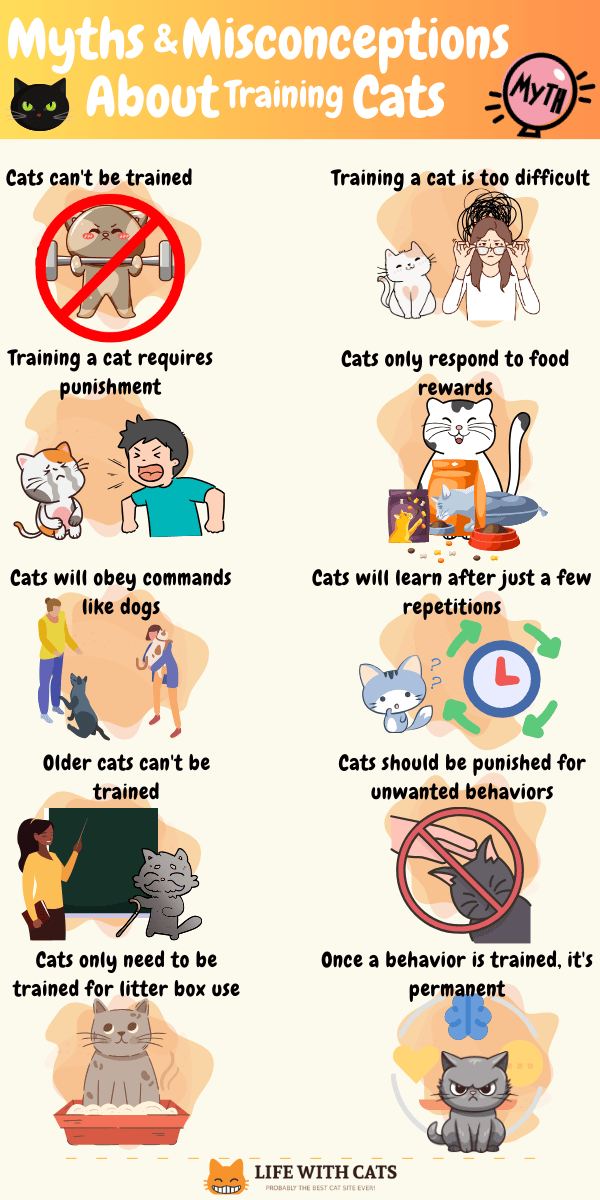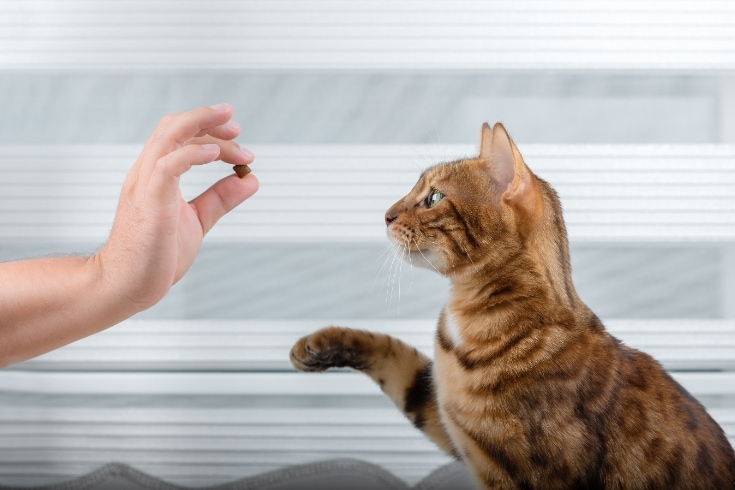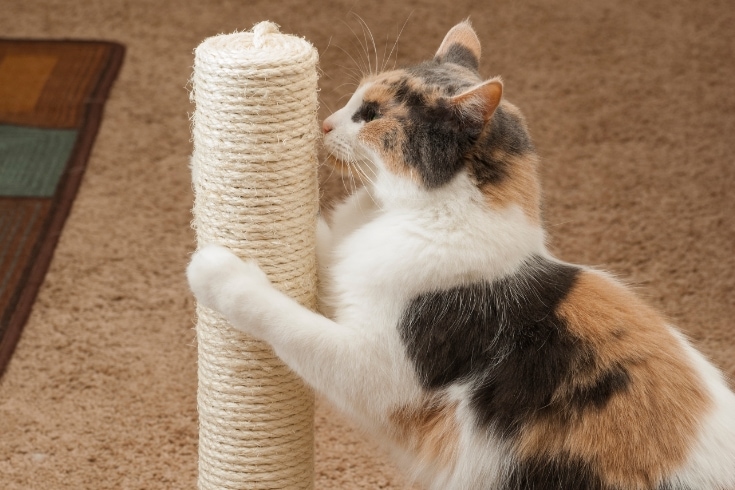Common myths about cat training are misconceptions or false beliefs that people often have about teaching and training cats. Many of those myths are not based on scientific evidence and can lead to misunderstandings about your cat’s behavior and needs.
For example, cats are typically labeled as aloof and untrainable, only responding to food rewards when they feel like it, and older cats can’t be trained at all. But the truth is that our furry feline friends can be loving, playful companions who can learn simple commands if you’re patient and consistent.
So, are cats trainable? Yes, cats of all ages are usually trainable to a certain extent, although that varies between individuals.
And are cats trainable like dogs? Well, that depends on the cat’s personality, how much time you can devote to the kitty’s lessons, and what you want the cat to do. You can teach a cat to fetch a ball and walk on a harness and leash, just like a dog. Cats are not currently trained to be service animals like dogs and miniature horses, although feline therapy pets are becoming more commonplace.
Keep reading as we debunk many of the most common myths about cat training and our feline friends. We reckon you’ll be shocked and amazed by what you’ll learn!
What Are The Myths and Misconceptions About Training Cats?

Common myths about cat training can put you off from trying to teach your beloved cat the simplest of tricks. But what’s true, and what’s a myth?
Keep reading to find out what’s what and debunk some of those misconceptions!
Cats Can’t Be Trained
Many people assume that cats are independent creatures that don’t interact with their owners except at feeding times and to sit on a lap occasionally.
However, cats can be trained to perform simple tricks, such as coming to call, “sit,” “stay,” “play dead,” and sit pretty! Even older felines can learn new tricks, including more advanced learning like rolling over, jumping through hoops, and even completing simple agility courses.
Training A Cat Is Too Difficult
People assume that because cats are notoriously independent animals, they can’t be trained easily.
Provided you use positive reinforcement training methods, patience, and a consistent approach, training a cat is not too difficult. In fact, training a cat can be more straightforward than teaching a dog simply because cats are smaller and less boisterous.
Training A Cat Requires Punishment
Never punish your cat during training! That will only frighten your pet and could worsen any undesirable behavior.
Instead of punishing your cat, only give her a reward when she does what you are asking her to do. If your cat seems to be struggling to understand a new command, try taking a few steps back and ask her to do a trick she understands and is confident performing.
Cats Only Respond To Food Rewards

Because many cats only seem interested in getting fed by their owners, many people assume their pets will only respond to food rewards.
Not all cats are motivated by food rewards and treats! In fact, many felines prefer to be petted or would rather have a playtime session with their doting owner.
For example, one of my cats doesn’t like treats and would prefer a head rub or a back scratch to a morsel of food.
Cats Will Obey Commands Like Dogs
This is true; cats will obey many commands just like dogs. You can teach your cat to sit, stay, come when called, fetch toys when asked, and even learn how to complete a small agility course.
Cats are generally more independent than dogs, so they can sometimes take longer to train, and their attention is more likely to be distracted by birds fluttering outside the window and other cats in their garden.
Cats Will Learn After Just A Few Repetitions
Now, that really depends on the individual cat. Some cats will learn after just a few repetitions of a simple command, whereas others can take weeks to learn what is essentially a fairly straightforward trick.
Some cat breeds are more trainable than others, such as Siamese and Maine Coons, whereas Persians can be slower to catch on.
Older Cats Can’t Be Trained

They say you can’t teach an old dog new tricks, but that’s definitely not the case with senior cats, and it’s one of the most common myths about cats!
It’s true that older cats often take longer to train because they have become set in their ways and can resist change. However, patient, consistent training generally pays dividends, and even a senior cat over ten years old can learn a few basic commands relatively quickly.
Cats Should Be Punished For Unwanted Behaviors
You should never punish your cat for unwanted behaviors, such as scratching furniture or relieving herself outside her litter box.
First, you should determine why your cat displays unwanted behavior, especially if she has been well-behaved beforehand. Often, a formerly well-behaved cat who suddenly starts acting up or becomes aggressive has an underlying health condition causing discomfort or pain.
So, I recommend having your cat checked over by your vet to make sure nothing is bothering her physically. Once you know your cat is fit and well, you can retrain her to correct the unwanted behavior.
For example, if your cat scratches your furniture, invest in a scratching post and train her how to use it using positive reinforcement methods.
Cats Only Need To Be Trained For Litter Box Use
Most non-cat people assume that you only need to teach a cat to use a litter box.
However, cats are naturally very clean creatures and won’t mess in the house unless they don’t have access to a clean litter box. So, training your cat how to use the litter box is generally a quick and painless process, even with a former feral or stray cat from a rescue or shelter.
However, that doesn’t mean you can’t train your cat to perform many simple tricks to impress your friends and behave well around your home. Training your cat helps build a stronger bond between you and your furry friend and is great fun for both of you.
Once A Behavior Is Trained, It’s Permanent

Generally speaking, behaviors such as litter box training and coming when called are pretty much permanent, largely because they are both used on a daily basis. However, tricks not often used, such as rolling over, sitting pretty, and playing dead, can be forgotten, so you need to keep practicing them as part of your cat’s daily training session.
What Is The Difference Between Training Cats Vs. Dogs?
The differences between cats and dogs when it comes to training are quite striking, although there are similarities, too.
Communication
As pack animals, dogs tend to look to their human owner as their pack leader. Canines are generally eager to please and respond very well to consistent commands and positive reinforcement.
In contrast, cats tend to be more independent creatures, descended from wild, solitary hunters who generally lived alone. Cat communication is very subtle compared to dogs, and felines rely more on body language and vocalization than canines. For that reason, you need a good understanding of how your cat communicates so that you can “talk” her language during training sessions.
Training Goals

Dogs are generally taught to sit, stay, be well-socialized with other animals and humans, and be potty trained. Cat training goals are fairly similar but include practical behavior training, such as using a scratching post instead of your sofa.
Motivation
Dogs tend to be food-driven; many will do anything for a tasty treat and verbal praise from their owners! Although many cats can be motivated by treats, some are equally happy with playtime, a head rub, or a quick chin scratch as a reward.
Training Sessions
Both cats and dogs benefit from having short, regular training sessions. However, cats generally have a shorter attention span than dogs, so their training sessions should be spontaneous and shorter.
Training Approach
Both cats and dogs respond best to a positive reinforcement approach when it comes to training. Aversive training methods can be extremely counterproductive, making your pet frightened or aggressive and damaging the special bond you share.
Needless to say, you must always use positive, reward-based training methods when teaching cats and dogs.
Social Nature

Dogs are highly social animals that usually love working alongside their human companions and often view training as a form of play or bonding.
Cats can be equally as social but more on their terms. For a cat, building trust is crucial for successful training, but once that trust is established, most cats love the interaction, and physical and mental stimulation that training provides.
Are Cats Trainable?
Yes; cats are much more trainable than many people realize!
Cats of all ages can be taught simple commands like “sit” and “stay” and even a few more demanding tricks, including jumping through a hoop or negotiating a small obstacle course. Of course, your training efforts’ success depends on your cat and the amount of time you can devote to training her.
You can even use training to moderate your cat’s undesirable behaviors, such as scratching your furniture or getting aggressive around mealtimes.
Never use aversive training methods when trading your cat. Cats respond much better to positive reinforcement and reward-based training, and negativity and punishment will only be destructive.
What Are Other Common Misconceptions Or Myths About Cats?
Here are other myths about cats that aren’t necessarily true, depending on your point of view!
Black Cats Are Unlucky

The superstition that black cats are unlucky is rooted in medieval Europe, when many people believed black cats were witches in disguise or could be associated with evil forces. Thankfully, today, it’s well-known that a cat’s coat color has no bearing whatsoever on its character or fortune.
However, if you crashed your car because you swerved to avoid a black cat in the street, you might not be convinced that ebony felines are especially lucky for you!
All Cats Hate Water
Although many cats steer clear of water, it’s not universally true that all cats hate getting wet, and many are extremely competent swimmers. For example, the Turkish Van is also known as the “Swimming Cat” because of its love of water, taking its name from Lake Van in southeastern Turkey, where the cats originate. Unlike most cats, this rare and ancient breed has a single coat of water-resistant fur without an undercoat, meaning they don’t get waterlogged like most other feline varieties.
Interestingly, when I was a child, I owned a cat called Smokey that would happily dive into the bathtub and swim around. Mind you, he was a Persian Blue, not a Turkish Van, so I guess he was the exception rather than the rule when it comes to cats and water!
Cats Are Unloving, If You Want A Loving Pet Get A Dog
This myth stems from people’s misunderstanding of feline social structures and communication. In reality, cats can be every bit as affectionate and loyal as dogs, but they might express their feelings differently.
Cats Always Land On Their Feet

Although it is true to say that cats have a unique skeletal structure that enables them to right themselves during a fall, that doesn’t guarantee your kitty will always land on her feet, especially if she tumbles a short distance.
Do Cats Have Nine Lives?
This is a popular myth that most likely originated because of the feline’s ability to escape unscathed from potentially dangerous situations. The truth is, that cats have only one life, although their agility and sharp reflexes can sometimes give the impression that our furry friends have multiple lives.
Cats Only Purr When They Are Happy
Although cats purr when they are content, they can also purr when anxious, in pain, or even close to death. Purring is a form of communication that cats use to express different feelings and is not solely a way of saying they are happy.
Cats Can See In Complete Darkness?
Although it’s true to say that cats have exceptional night vision, they cannot see in complete darkness. Cats’ eyes are adapted to see extremely well in low light, making them efficient hunters during dawn and dusk.
Did you ever notice that your cat’s eyes glow red at night? That phenomenon is caused by the light reflecting from a layer of tissue at the back of the cat’s eyeball behind the retina called the tapetum lucidum. The tapetum lucidum acts like a mirror, reflecting any light not absorbed by the light sensor cells in the retina.
Interestingly, some cats’ eyes glow green rather than red, depending on their eye color. For example, blue eyes glow red, whereas green and golden eyes glow green! Take a look at your cat tonight and see what color her eyes glow in darkness!
Cats Are Nocturnal

Although many cats are more active at night and enjoy going out hunting when the sun goes down, felines are actually classified as crepuscular, meaning they are most active at dawn and dusk.
You Should Give Your Cat Cows Milk
It is something of an urban myth that cats enjoy a saucer of milk or cream. In fact, most adult cats are lactose intolerant, which means they cannot digest the lactose found in cow’s milk. A dish of milk could cause stomach upsets and diarrhea, so fresh water is the best form of hydration for your cat.
That said, one of my cats loves to lick a tiny spot of natural yogurt from the tip of my finger as an occasional treat!
Cats Do Not Like Other Cats
Cats are territorial animals that do not appreciate interlopers on their patch! However, provided proper introductions are made, harmonious multi-cat households can happen once the pecking order has been established.
Cats Are Solitary Animals And Like To Be Left Alone
Cats have a reputation as being rather independent, solitary creatures that can take or leave human company. However, although it is true that many cats enjoy a bit of alone time every now and then, most also crave interaction and playtime with their human families.
FAQs
In this section of our guide, we answer some of the most frequently asked questions about the common myths regarding cat training.
Will Rubbing Butter On A Cat’s Paws Help It Find Its Way Home?
No, the idea that rubbing butter on a cat’s paws will help it find its way home is an old wives’ tale!
There is no scientific evidence to support this claim, and it’s unclear how this myth originated, but years ago, some people thought that if you rubbed butter on a cat’s paws when you moved to a new home, she would spend time licking the butter off and, in doing so, become familiar with her new surroundings. That would supposedly make the cat less likely to run off and get lost.
However, cats have a keen sense of smell, and they use scent markers in their paws and faces to navigate their territory. That’s why your cat scratches at certain spots around your garden and will use a scratching post in your home.
Simply licking butter off their paws isn’t likely to enhance this ability or replace the significance of your feline friend’s natural pheromone scent markers.
Can Cats Be Trained To Perform Tricks?
Yes, you can train most cats of all ages to perform simple tricks. In fact, most cats can learn similar tricks to those traditionally taught to dogs!
For example, you can teach your cat to fetch a ball, sit, stay, come when called, and even walk on a leash.
Is Punishment An Effective Training Tool For Cats?
Absolutely not! If you punish your cat during training sessions, you will make her afraid and resentful, potentially damaging the special bond you are working so hard to form. When training your cat, always use positive reinforcement and reward-based methods. Take your time, be consistent in your approach, and always take a few steps back if your cat struggles to understand what you want her to do.
Are Cats Less Intelligent Than Dogs For Training?
Although cat intelligence varies between individuals, most cats are just as bright as dogs when it comes to training. That said, cats are undoubtedly naturally more independent creatures than canines and sometimes have a shorter attention span, so it can take your feline friend longer for the penny to drop.
Can I Use The Same Training Techniques For Cats And Dogs?
Yes, more or less, the same training techniques work equally well for cats and dogs. Always use positive reinforcement methods when training your pet, be consistent in your approach, use verbal cues that are clear and easy for your pet to understand and remember, and keep training sessions short and fun.
The main difference between training cats and dogs is that dogs tend to be more food-oriented when it comes to rewarding them, whereas cats are just as happy with praise or an enjoyable, interactive game.
Do Cats Respond To Treats In Training?
Yes, many cats do respond well to treats during training. However, others will be just as happy with your verbal praise, petting, and a fun playtime session as a reward for doing well.
Conclusion
You can see from our fun article that although some of the common myths about cats and cat training do have a grain of truth, many can be effectively debunked!
One key takeaway is that you should never use punishment when training your cat. Punishment only makes your cat afraid and resentful, potentially damaging your relationship and even undoing your previous good work. In addition, cats can be just as easy to train as dogs, although your approach might differ slightly since cats have a shorter attention span and can be more independent than their canine counterparts.
So, don’t believe all those myths you hear about cats, such as black cats being unlucky or cats being solitary, unloving creatures. Instead, approach training your cat with an open mind, use positive reinforcement methods, and be quick to praise and reward your feline friend when she does the right thing.